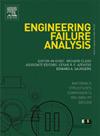复杂载荷条件下超深顶驱钻机主轴螺纹接头失效行为分析
IF 5.7
2区 工程技术
Q1 ENGINEERING, MECHANICAL
引用次数: 0
摘要
针对超深顶驱主轴螺纹接头在复杂极端工况下的过早失效和疲劳开裂问题进行了研究。基于API标准,建立了主轴螺纹接头三维有限元模型,系统研究了主轴螺纹接头在补偿扭矩、轴向拉力、钻井液压力、径向扰动等复杂组合载荷作用下的应力分布特征。采用Fe-safe多轴疲劳模型进行疲劳寿命预测,量化表面粗糙度和残余应力对疲劳寿命的影响。结果表明:在15000 m钻柱轴向载荷作用下,第一螺纹根部是应力集中和疲劳破坏的高危区域,最大应力达到972.6 MPa;根据布朗-米勒模型,故障发生在27,073次循环之后。通过具有代表性的现场故障实例,验证了模拟预测的有效性。研究结果为超深顶驱钻井系统锥形螺纹接头疲劳寿命预测和可靠性设计提供了理论依据和工程参考。本文章由计算机程序翻译,如有差异,请以英文原文为准。
Failure behavior analysis of the main shaft threaded joint of ultra-deep top drive drilling rig under complex loading conditions
This study aims to address the issues of premature failure and fatigue cracking of ultra-deep top drive main shaft threaded joint under complex and extreme operating conditions. A three-dimensional finite element model of the main shaft threaded joint is developed based on API standards to systematically investigate the stress distribution characteristics under complex combined loads, including make-up torque, axial tension, drilling fluid pressure, and radial disturbance. Fatigue life prediction was then carried out using Fe-safe with multiple multiaxial fatigue models, and the influence of surface roughness and residual stress was quantified. The results indicate that the root of the first thread is a high-risk region for stress concentration and fatigue failure, where the maximum stress reaches 972.6 MPa under the axial load of a 15,000 m drill string. According to the Brown–Miller model, failure occurs after 27,073 cycles. Validity of the simulation predictions is confirmed by representative field failure cases. The findings of this study provide a theoretical basis and engineering reference for fatigue life prediction and reliability design of tapered threaded joints in ultra-deep top drive drilling systems.
求助全文
通过发布文献求助,成功后即可免费获取论文全文。
去求助
来源期刊

Engineering Failure Analysis
工程技术-材料科学:表征与测试
CiteScore
7.70
自引率
20.00%
发文量
956
审稿时长
47 days
期刊介绍:
Engineering Failure Analysis publishes research papers describing the analysis of engineering failures and related studies.
Papers relating to the structure, properties and behaviour of engineering materials are encouraged, particularly those which also involve the detailed application of materials parameters to problems in engineering structures, components and design. In addition to the area of materials engineering, the interacting fields of mechanical, manufacturing, aeronautical, civil, chemical, corrosion and design engineering are considered relevant. Activity should be directed at analysing engineering failures and carrying out research to help reduce the incidences of failures and to extend the operating horizons of engineering materials.
Emphasis is placed on the mechanical properties of materials and their behaviour when influenced by structure, process and environment. Metallic, polymeric, ceramic and natural materials are all included and the application of these materials to real engineering situations should be emphasised. The use of a case-study based approach is also encouraged.
Engineering Failure Analysis provides essential reference material and critical feedback into the design process thereby contributing to the prevention of engineering failures in the future. All submissions will be subject to peer review from leading experts in the field.
 求助内容:
求助内容: 应助结果提醒方式:
应助结果提醒方式:


